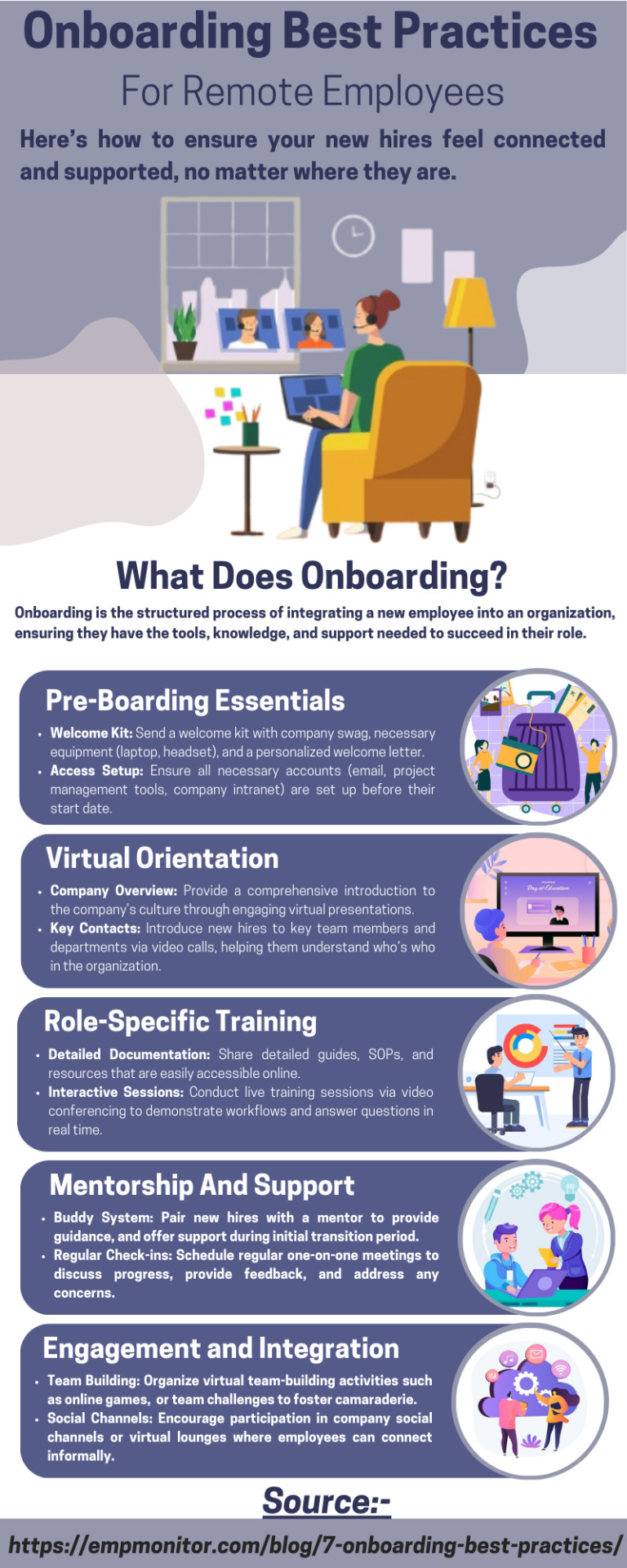#RemoteOnboarding
Explore tagged Tumblr posts
Text
🌍 Randstad Goes Fully Digital — What's Next in HR?
In a behind-the-scenes look at Randstad’s French headquarters in Saint‑Denis (Dec 4, 2020), employees—masks on— gather for a meeting amid evolving workplace norms. This Dutch HR powerhouse isn’t just playing catch-up. It’s racing to lead the online temping market by 2025 with a fully digital platform.
What this means for the future of work:
🚀 Digital staffing on the rise: Temp assignments and gig work are shifting online — globally.
🌐 Remote recruitment: Firms are rethinking how they hire, assign, and support workers from afar.
🧠 HR on the cutting edge: Online systems demand stronger frameworks around onboarding, compliance, and digital wellbeing.
Whether you're studying HR, digital transformation, or leadership in people-centric industries, this is a moment to learn from.
If you're tackling assignments that explore the digital shift in talent acquisition, workforce planning, or tech-enabled HR — don't go it alone.
👉 CIPD Assignment Help 👈 provides expert support tailored to your academic level, helping you frame your analysis with industry insight and professional polish.
#Randstad#HRTech#DigitalTemping#FutureOfWork#OnlineRecruitment#TempStaffing#CIPDAssignmentHelp#HumanResources#GigEconomy#PandemicWorkplace#DigitalTransformation#HRDevelopment#WorkplaceInnovation#StudySupport#TalentAcquisition#HybridWork#WorkforceStrategy#LifelongLearning#RemoteOnboarding#ProfessionalGrowth
0 notes
Text
Why Drug Screening Should Be an Essential Part of Background Verification in India
In today's fast-paced and competitive business environment, organizations are increasingly prioritizing employee integrity, safety, and productivity. While traditional background verification checks such as criminal records, address verification, and educational credentials have become standard, one critical area still remains underexplored in India—drug screening.

Why Drug Screening Matters
Drug abuse can have severe consequences in the workplace, including safety hazards, poor performance, absenteeism, and legal liabilities. Industries such as transportation, manufacturing, healthcare, and construction face higher risks, where an employee under the influence could endanger not only their own lives but also those of others.
In countries like the United States, drug testing is already a well-integrated part of pre-employment and periodic screening protocols. However, in India, despite growing awareness around substance abuse, drug screening is not yet mainstream in corporate hiring practices. This raises the question—should drug screening become a standard part of background checks in India?
The Case for Mandatory Drug Testing
Workplace Safety: Especially in roles involving machinery, driving, or patient care, being under the influence can lead to accidents, errors, or even fatalities.
Productivity and Performance: Substance abuse often correlates with absenteeism, reduced output, and frequent errors—costing companies valuable time and resources.
Legal and Regulatory Compliance: As compliance frameworks evolve, organizations may soon be required to demonstrate they’ve taken proactive steps to ensure a drug-free workplace.
Reputation Management: Hiring an employee later found involved in substance abuse can damage a brand’s credibility, especially in customer-facing or high-responsibility roles.
Challenges to Implementation
Despite its importance, drug testing in India is not without challenges:
Lack of Clear Guidelines: There’s currently no central regulatory body mandating drug screening during hiring.
Privacy Concerns: Candidates may view drug testing as intrusive.
Cost Implications: Some employers, especially SMEs, may hesitate due to the perceived cost of implementing such checks.
A Balanced Approach
To strike a balance, organizations can start with role-based screening, focusing on high-risk jobs. Additionally, transparency in communication, informed consent, and collaboration with reliable third-party background verification partners like OnGrid can ensure the process remains ethical and compliant.
Final Thoughts
Drug screening is more than a checkbox—it’s a preventive measure to foster a safe, efficient, and trustworthy workplace. As India’s work culture becomes more aligned with global standards, integrating drug testing into background verification could be a forward-looking step that benefits both employers and employees.
#VideoKYC#DigitalKYC#RuralIndia#FinancialInclusion#RemoteOnboarding#KYCVerification#Fintech#Gridlines#KYCSimplified#BharatOnboarding
0 notes
Text
How Oracle HCM Solutions Helped Us Discover What Was Broken in Our Onboarding Process
At first glance, our hiring process at Avion Technology seemed to work just fine. We could attract talent, conduct interviews, and send out offer letters quickly. But as we began to scale, it became clear: our onboarding process had cracks we hadn’t even noticed.
While no single step was “broken,” the system was far from efficient. New hires were left waiting. HR was swamped. IT processes lagged. The result? A disjointed employee experience that impacted productivity and morale.
That’s when we turned to Oracle HCM Solutions—and everything changed.
What Wasn’t Working (That We Didn’t See Coming)
We weren’t short on talent. We were short on tools and structure. Here are just a few friction points we faced:
Paper-based onboarding documents
Manually triggered IT setups
Multiple systems for HR, payroll, and benefits
Repetitive data entry for every new hire
Delays in communication and inconsistent onboarding timelines
Individually, these issues were small. Together, they formed a major bottleneck.
The Shift to Oracle HCM Cloud
Switching to Oracle HCM Solutions was more than a tech upgrade—it was a strategic move. Here's what changed for the better:
Automated workflows drastically reduced onboarding time
E-signature tools removed paper-based delays
Employee self-service portals handled most new hire questions
Integrated systems connected HR, IT, and leadership in real time
The result? Faster onboarding, less HR stress, and a confident start for every employee.
Key Features That Make Oracle HCM Solutions Stand Out
Whether you're leading a mid-sized business or scaling a larger enterprise, Oracle HCM Cloud comes with a full suite of tools that make onboarding and HR management more intelligent:
Core HR: Unified employee records, global compliance
Talent Management: Smart recruiting, goal-setting, and performance tracking
Workforce Rewards: Compensation and benefits tools
Workforce Management: Time tracking, scheduling, leave requests
Employee Experience: Personalized onboarding journeys and AI-powered HR help desks
Analytics & Payroll Integration: Real-time data visibility and predictive insights
Why Hybrid Teams Need HCM More Than Ever
In hybrid and remote work models, smooth onboarding is no longer optional—it’s essential.
Oracle HCM Solutions are built to support distributed teams with:
Remote completion of onboarding tasks
Automated IT and HR coordination
Unified access to company policies, welcome kits, and team intros
Mobile-first design for anytime, anywhere accessibility
Manager dashboards to track onboarding progress
For companies managing multiple locations or remote employees, this centralized approach removes friction and creates consistency.
How We Help Others Do the Same
At Avion Technology, we’re not just users of Oracle HCM—we help other businesses implement it too. Our team offers:
Full implementation and configuration
Custom system integrations (ERP, payroll, CRM)
Workflow automation and employee portals
Post-launch support, training, and optimization
From our base in Schaumburg, Illinois, we help growing businesses across the U.S. modernize their HR and onboarding operations.
Frequently Asked Questions (FAQs)
1. Is Oracle HCM Cloud a good fit for small businesses? It works best for mid-size to large enterprises, especially those with complex workflows or distributed teams.
2. How long does it take to implement? Typical implementation takes 8–16 weeks, depending on customization and modules selected.
3. Can Oracle HCM integrate with payroll or CRM platforms? Yes. It integrates with popular systems like QuickBooks, ADP, and NetSuite.
4. What support is available post-implementation? Ongoing support includes training, user adoption, and continuous system optimization.
5. What makes Oracle HCM ideal for remote teams? Self-service onboarding, mobile access, and cloud-based tools ensure a smooth experience from any location.
Hiring is just the beginning. Let us help you deliver a seamless onboarding experience that retains top talent, boosts productivity, and scales effortlessly.
Get a Free HCM Readiness Assessment Let’s discover what’s slowing your onboarding down—and how Oracle HCM can fix it.
Contact Avion Technology today to get started.
#OracleHCM#HCMsolutions#DigitalOnboarding#HRTech#EmployeeExperience#HRTransformation#RemoteOnboarding#CloudHR#FutureOfWork#OraclePartner#TalentManagement#EmployeeSuccess#Avion Technology
0 notes
Text

In this infographics, we will learn about some onboarding best practices for remote employees
#onboardingbestpractices#remoteonboarding#onboardingremoteemployees#bestonboardingpractices#staffmanagementtools#workforcemanagementtools#remoteworkforcemanagement
0 notes
Text

Challenges of Remote Onboarding.
0 notes
Photo

Onboarding new employees remotely requires the right amount of coordination, strategies, and proper tools. Follow this checklist to welcome remote workers to your organization. If you need help with hiring and onboarding remote employees, contact us: www.sourceinfotech.com
0 notes
Photo

𝐇𝐨𝐰 𝐂𝐚𝐧 𝐖𝐞 𝐌𝐚𝐤𝐞 𝐕𝐢𝐫𝐭𝐮𝐚𝐥 𝐎𝐧-𝐛𝐨𝐚𝐫𝐝𝐢𝐧𝐠 𝐏𝐫𝐨𝐜𝐞𝐬𝐬 𝐒𝐮𝐜𝐜𝐞𝐬𝐬𝐟𝐮𝐥 ?
𝗖𝗹𝗶𝗰𝗸 𝗛𝗲𝗿𝗲 : https://hradminist.com/virtual-employee-onboarding-process/
To get through the list of 10 fruitful strategies of on-boarding remote employees.
0 notes
Photo

A #RemoteOnboarding checklist is not enough! Set your new employee relationship up for success by fostering a sense of belonging with these factors. https://bit.ly/37gDjUQ
#TalentManagement#TalentStrategies#Onboarding#COVIDPandemic#Hiring#OrganizationalChange#TalentManagementLeaders#WorkforcePlanning#WorkforcePlan#TalentManagers#RemoteWorkforce#WorkforceDevelopment#Employeeengagement#TMI
0 notes
Text
HRZone: Five secrets to successful remote onboarding during a crisis: https://t.co/2eJwmfNGiW #remoteonboarding #onboarding https://t.co/FNvId6Uvvd
HRZone: Five secrets to successful remote onboarding during a crisis: https://t.co/2eJwmfNGiW #remoteonboarding #onboarding pic.twitter.com/FNvId6Uvvd
— Ashish Bhalla (@Ashish__Bhalla) April 29, 2020
from Twitter https://twitter.com/Ashish__Bhalla April 28, 2020 at 09:26PM via IFTTT
0 notes
Text
Why Video KYC Is the Game-Changer for Rural India’s Financial Inclusion
India’s financial ecosystem has seen rapid digital transformation in recent years, but rural inclusion still lags behind. With over 65% of the population living in rural areas, delivering accessible financial services is both a challenge and an opportunity. Video KYC is emerging as a powerful tool to address this gap—offering a fast, secure, and paperless way to verify customers without the need for physical presence.

What Is Video KYC?
Video KYC is a remote, real-time verification process that allows individuals to complete their identity checks through a live video call with a KYC officer. It uses technologies like face match, OCR (Optical Character Recognition), and AI-driven fraud detection to ensure security and compliance. This method is compliant with regulatory standards laid out by the Reserve Bank of India (RBI) and is rapidly gaining adoption among banks, fintechs, NBFCs, and insurance providers.
Why Rural Markets Need Video KYC
Traditional KYC methods require visiting branches, submitting physical documents, and waiting for days or even weeks for verification—especially problematic in remote locations. In contrast, Video KYC removes these hurdles by:
Enabling remote access: Customers can complete verification from their homes via smartphones or tablets.
Reducing onboarding time: The entire KYC process can be completed in minutes.
Ensuring compliance: AI-powered verification ensures AML (Anti-Money Laundering) and CFT (Counter-Terrorism Financing) compliance.
Lowering operational costs: Eliminates the need for physical infrastructure and in-person field agents.
Real-World Impact
Financial institutions and fintech platforms are now using Video KYC to bring digital accounts, credit services, micro-loans, insurance, and even investments to rural India. This shift is helping previously excluded populations participate in the formal economy and build credit histories.
A significant benefit is the democratization of financial services—where an individual in a Tier 3 village has the same onboarding experience as someone in a metro city. For MSMEs and gig workers in rural markets, this means faster access to capital and support systems.
Why Gridlines?
Platforms like Gridlines are helping bridge this rural-urban gap through their robust, API-first Video KYC solution. With real-time face match, liveness checks, and seamless integration, Gridlines empowers businesses to scale their outreach without compromising on compliance or security.
Final Thoughts
In a country as diverse and geographically vast as India, Video KYC is more than just a technology—it’s a catalyst for inclusive growth. As digital Bharat continues to rise, adopting Video KYC is no longer optional—it’s essential.
#VideoKYC#DigitalKYC#RuralIndia#FinancialInclusion#RemoteOnboarding#KYCVerification#Fintech#Gridlines#KYCSimplified#BharatOnboarding
0 notes
Text

Challenges of Remote Onboarding.
1 note
·
View note
Text
Tweeted
HRZone: Five secrets to successful remote onboarding during a crisis: https://t.co/2eJwmfNGiW #remoteonboarding #onboarding pic.twitter.com/FNvId6Uvvd
— Ashish Bhalla (@Ashish__Bhalla) April 29, 2020
0 notes